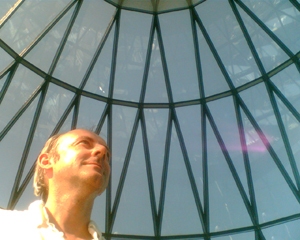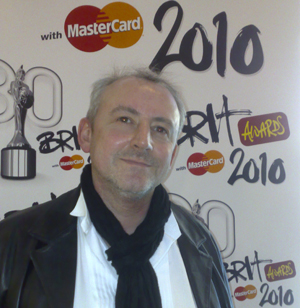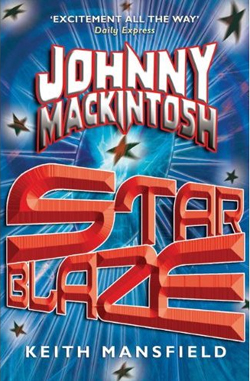Career interview: Fiction writer and maths editor
Plus bumped into an old friend at the International Congress of Mathematicians this year: Keith Mansfield is the author of the Johnny Mackintosh series and commissioning editor for mathematics at Oxford University Press at the same time. In this interview he tells us how his he's built a career around his two talents, writing and maths.
A budding genius

Keith Mansfield.
"No-one in my family was at all mathematical, so it's hard to pin down where my early interest in maths came from," says Keith, talking to Plus in his beautiful London flat overlooking the Gherkin. "I devoured popular science books and TV shows. Like for a lot of people, it was the big questions of physics — the Universe, cosmology, particle physics, etc — and how they relate to mathematics that fascinated me. "
Keith was keen indeed: at the age of 15 he wrote to CERN begging a summer job and to Stephen Hawking telling him he was wrong about his famous black hole radiation. Hawking never replied and CERN sent back a ten-page application form asking Keith to detail his academic publications — but he wasn't deterred. "It sounds ridiculous, but I quite expected that I was one day going to revolutionise science and win the Nobel Prize in physics."
Recognising that greatness in physics is rooted in mathematics, Keith decided to study the Mathematical Tripos degree at Cambridge, choosing an option of maths with physics. It was the big ideas he was interested in, not messy lab work, so this more theoretical degree seemed like the best option. Alas, the Tripos comes with a lot of pure maths, and Keith found this hard and frustrating. "For the first time in my life I found mathematics difficult," he says. "I went into the degree with all these great, big ideas, but then found I had to get down and dirty with details and minutiae — it felt like solving pointless puzzles rather than thinking about the big picture. Looking back I wanted to run before learning properly how to walk, but a lot of it just didn't hold that much interest for me." Shelving his Nobel Prize dreams for the moment, Keith harked back to his other talent. He had always enjoyed writing, so what better way to combine his two loves than going into academic publishing.
First steps in the publishing world
Keith's first job after university landed him right in the middle of the publishing empire of Robert Maxwell, MP and media mogul, whose mysterious death in 1991 revealed equally mysterious holes in his finances. Maxwell had started out with a company called Pergamon Press, now an imprint of the academic publisher Elsevier, which attempted to bring Eastern block science to the West. Maxwell had made a fortune with Pergamon Press, sold it, lost his fortune, somehow bought Pergamon back again, and made another fortune, before famously taking over the Mirror Group. "My role at Pergamon was to edit science encyclopedias," explains Keith. "These were very technical reference works, including the Encyclopedia of Materials Science and Engineering and the Systems and Control Encyclopedia, and lots of spin-offs on things like superconductors or traffic and transportation systems."

Keith at the top of the Gherkin in London.
Keith was part of a small team of editors, editing the encyclopedia articles that had been written by experts, checking them, bringing them into a uniform style, and thus seeing each large volume through to publication. "It was great getting this kind of overview of different areas," he recalls. Of course you can't be an expert on all of them, but there was an academic editorial board that was there to advise and help pick the authors of articles. The encyclopedias were major multi-volume reference works providing the first unified explorations of the scientific areas they covered. Interestingly, one of the biggest orders for the Encyclopedia of Materials Science and Engineering came from the Iraqi government, at the time it was attempting to build its supergun in the late 1980s. "A lot of material in the encyclopeida would have been helpful for that," says Keith. "I'm not sure this was a particular good use of it. But I also know that the encyclopedias are still around, so they are still useful and have stood the test of time."
Maxwell's Bond-villan lifestyle provided other entertainments too. There were parties at his manor house which saw Maxwell flown in by helicopter and his throne-like boardroom chair, which Keith enjoyed sitting on in his absence. But despite the fun, Keith decided to move to another great academic publisher, Oxford University Press (OUP). His job at OUP, as editorial controller, involved working on science and medical books, mostly for graduates and researchers. As well as organising the copyediting, proofreading and briefing technical artists, he had to ensure any electronic files were compatible for printing. "Though not everything was computer-based back then. I once received a very large manuscript written in pencil!"
His heart, however, was set on a position further up the ladder: commissioning editor. "The commissioning editor is the person who asks somebody to write a book and is involved with the book from the first glimmer of an idea. It can take years for a book to be written and you may still be working with an author long after publication; it's a long-term relationship you're building. I was very keen to move up to commissioning editor at OUP."
Adventures in cyber space
Sadly, OUP kept defaulting on their promise to promote him, but meanwhile Keith made a marvellous discovery: "When we got the first computers at OUP I discovered this thing called the Internet. This was way back in the early 1990s when there weren't even graphics-based browsers. I used a text browser called Lynx, which had coloured text appearing on a black screen. But I still thought the Internet was fantastic." Keith was particularly thrilled at the access the Internet provided to the world of science and research. For example, he found the website of the Mauna Kea telescope in Hawaii where he could look at its space pictures. He even invited a flatmate one night, who pressed the wrong button and inadvertantly began to download the entire Oxford University server to the telescope. Keith was banned from using OUP computers for three months as a result.

The good old days: a trusted floppy disc.
But when the first graphics based browser appeared on the scene, the Web took on a whole new meaning. A pioneering spirit, Keith taught himself hypertext and lobbied for OUP to build its own web presence. To impress potential employers, he even made a floppy disc with a hypertext CV on it. But rather than sparking interest, the disc was met with bafflement.
Eventually though, Keith's enthusiasm paid off. Someone at a company called Addison Wesley, now an imprint of the publisher Pearson, had dug up the CV disc Keith had sent them some time ago, was impressed, and offered him the job of commissioning editor. Not for maths or physics, but for computer science, but Keith was thrilled nevertheless.
"I did the company's computer science books for seven years. They had a really great computer science 'list' [that's jargon for publishing output]. I worked on undergraduate textbooks, human-computer interaction, and I did books on software engineering. I also started their computer games programming list — people don't realise just how much advanced maths is involved in graphics programming. We saw a lot of growth in computer science publishing while I was there, it was the time of the dot-com boom. Everybody had discovered the Internet and they were all falling over it."
The dot-com boom, however, was followed by the dot-com bomb. The market contracted, Pearson found it had way too many computer science editors, and Keith was made redundant.
Eurovision and The Wire
With characteristic optimism, Keith took redundancy in his stride. "Being made redundant is one of the best things that ever happened to me. Up until university, I had always done lots of fiction writing, though I had gradually stopped. After the redundancy I realised that I wanted to show off my creative side again and hopefully do some writing at the same time."

Keith at the 2010 Brit Awards.
Quite bizarrely, Keith soon found himself writing decidedly unscientific scripts for television. He had set himself up as a self-employed publishing consultant and landed a job publishing the books of the British Film Institute. It was at a BFI press screening that he found himself offering his free services to a TV producer in need of a script writer for a pilot show. The show was The Wire — not the Wire, but an ITV game show hosted by Jamie Theakston, which turned out never to get made. But Keith's foot was in the door and he ended up writing scripts for the likes of Lionel Ritchie, for An audience with Lionel Ritchie, and Paul Gambaccini for Sing it back. It may seem strange that accomplished broadcasters like Gambaccini have scripts written for them, but that's how TV works, and anyway, they, or their assistants, did get to approve the words Keith put in their mouths.
Keith also wrote the script for the 2005 Junior Eurovision Song Contest, presented by Michael Underwood, which was when his mathsy bent came to haunt him. "I was watching these kids singing, trying to think of something new and interesting to say, and by the end of it I went a bit mad. I wrote about how one of the songs was very metaphysical, about parallel lines meeting at infinity and other maths concepts. I thought, surely they will change this, but they ran with it and Michael Underwood did actually say it on the show!"
Johnny Mackintosh

Johnny Mackintosh: The spirit of London
The most important development during Keith's self-employed years was his return to writing fiction. "Just as I thought as a kid I was going to win the Nobel Prize, but got nowhere near it, I thought I was going to write the modern, cutting-edge novel," he says. "But I was never able to get very far. However, all through that time we saw the rise of Harry Potter and, like many people, I fell in love with the books."
One night, when walking back from his creative writing class, Keith had an epiphany: he was going to write a childrens' book, based on an idea he had had as a teenager, about a kid who gets abducted by aliens, meets the emperor of the galaxy, and comes back to save the Earth. His idea eventually turned into the Johnny Mackintosh books, published by Quercus, who signed Keith up for a three-part series. Two of the books, Johnny Mackintosh: The spirit of London and Johnny Mackintosh: Star Blaze are out and ready to buy, and the third is in the pipeline.
Keith has built his passion for science into the books. "I tried to write books which, apart from being good stories, contain some decent science too. Especially the second book, Star Blaze has some pretty advanced physics in it. Towards the end there's some relativity theory: Johnny Mackintosh travels very close to the speed of light, rushing to save the Earth, and that's when you see time dilation, basically time travel. Also, his spaceship is powered by a dark energy drive, which I have turned into an anti-gravity device for the book. Plus there is a quantum computer in the books, too."
Keith is proud of the success of the books: the first has been shortlisted for the Concorde Book Award and they have also been translated into other languages. But he also hopes that the books do their bit for science education. "In a way the books have a hidden agenda to get kids interested in science. I give talks at schools, but unlike other authors, who focus on the writing, I talk to them about time travel, aliens, and so on, in a proper scientific way."
As Plus can attest, the books make great reading for anyone who likes Harry Potter, science, science fiction, or all three of them. They appeal to readers from age 10 to age 100. The upper limit isn't an exaggeration, since Keith has a great-aunt of 105 who enjoyed the books immensely.
Full circle
During his years of self-empolyment, Keith didn't lose touch with maths. For Quercus he started a series called Fifty ideas you really need to know, which contains a book on fifty maths ideas, as well as books on philosophy, physics and more. The book on maths, authored by Tony Crilly, is one of the best-selling popular maths books there is. "Writing this book was an amazing effort for Tony, as no mathematician in the world can be on top of all these ideas: the book starts with zero and ends with the Riemann hypothesis. Tony did a brilliant job at covering all those things, and I helped soften the academic side to make it more accessible to non-mathematicians."

Johnny Mackintosh: Star Blaze
These days, Keith is wearing two hats. As well as working on the third book in the Johnny Mackintosh series (working title Battle for Earth), he has returned to OUP, having finally been given the position of commissioning editor for maths. "I have a lot of freedom in this job and can publish textbooks, research books and books for a popular audience."
In this job Keith gets to meet some of the best mathematical minds on the planet. Books he has published include Roger Penrose's Collected Works, as well as the Nobel laureate Subrahmanyan Chandrasekhar's book Newton's Principia for the common reader. "It's great to have people like Roger Penrose in my office and talk to them about questions in maths and physics. I could finally ask Penrose about black holes and Hawking radiation and if I was right when I wrote to Hawking as a kid. As it turns out, Hawking was right and I was wrong!"
Keith's double-stranded career might seem unusual, but he believes that there are plenty of opportunities around for those with a knack for maths and writing. "There are always jobs for literate mathematicians, because there are not many of us around. Most people in publishing are arts graduates. They can find it very intimidating to work on maths books/journals, so there's always demand for editors or proofreaders who understand the content. That's true for the popular books, just as much as research volumes or journals. Then there are publications such as Nature, Science, New Scientist and so on. In fact, I'd say the science communication agenda is very much on the rise, with plenty of courses in science journalism and writing. Understanding maths, and statistics, is a great background for explaining the origins of the Universe or the latest evidence from medical trials. Back in the 1980s everybody was stuck within their own subject boundaries, but nowadays things have gone the other way. The buzz word is 'interdisciplinary' — that applied across the sciences, but there are a lot of collaborations between the arts and science as well."
About the author
Marianne Freiberger is co-editor of Plus.
| You can buy the books and help Plus at the same time by clicking on the links on the left to purchase from amazon.co.uk, and the links to the right to purchase from amazon.com. Plus will earn a small commission from your purchase. |

More from Maths Careers
You can find out more about careers with mathematics on the Maths Careers website, which is run by the Institute of Mathematics and its Applications. In particular you might want to look at this career profile on the Maths Careers site: